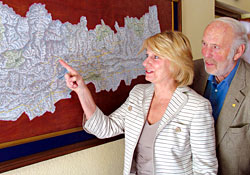|
|
| HOW ABOUT HERE? Marilyn and Jim Simons plan their rural health care strategy in Kathmandu on Monday (left) and their son Nick with a friend in Nepal in 2003. |
Nick's parents Jim and Marilyn Simons were devastated and decided to help Nepalis live healthier lives in Nick's memory. They flew to Kathmandu in their private jet and looked around. They were immediately impressed with the work being done at Patan Hospital and saw the overcrowded maternity ward. They decided to fund a new $1.5 million maternity hospital that is currently under construction in Lagankhel.
Jim Simons was a mathematics professor at MIT and Harvard where he worked on probabilities and found ways to predict trends in the stock market. He set up Renaissance Technologies which helped corporate clients with management of their investment portfolios and grew into a multi-billion dollar business.
Jim and Marilyn wanted to do something more for Nepal that would make a real long-term difference in rural health. With a task force of Nepali health experts led by former ambassador Bhekh Bahadur Thapa they set up the Nick Simons Institute (NSI) which was launched this week in Kathmandu.
"Rural health care is not a new problem and there are lots of people addressing the issue," Jim says, "what makes NSI unique is that it will do this job better than it has ever been done with an emphasis on quality training."
 HOW ABOUT HERE? Marilyn and Jim Simons plan their rural health care strategy in Kathmandu on Monday (left) and their son Jim with a friend in Nepal in 2003. |
NSI has drawn up a strategy to select and train health personnel who are most likely to remain in the villages, and not migrate to the cities once they learn skills. It is looking at innovative ways of keeping doctors in rural hospitals by paying for their children to go to school in the cities and giving them telephone and internet access. Trainees will develop skills in existing government and mission hospitals like Tansen, Rukum, Dadeldhura and Okhaldhunga.
"Nepal has doctors, but they are in the wrong places, and it isn't enough to train health workers we have to make sure they stay where they are needed," says Mark Zimmerman Executive Director of NSI. There is great disparity in health care in Nepal: Kathmandu has 117 doctors for every 100,000 population but the figure is 3.3 for other towns and 0.7 for remote areas.
Jim and Marilyn Simons say they have a great sense of fulfilment that after three years an institute named after their son is finally getting off the ground.
"You know, we'd probably never have come to Nepal if Nick hadn't been here," says Marilyn, "he was so happy in Nepal, he said he wanted to live and work here. Nick left us a gift by opening a whole new world to us."



